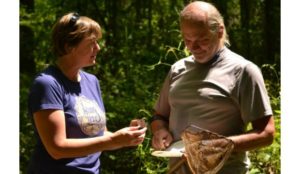SRS home to Rainbow Bay, longest ever amphibian study
Thomas Gardiner
The Augusta Chronicle
April 22, 2017

Cold War relics, retired defense nuclear reactors, and monolithic concrete waste processing buildings dot the 310-square-mile landscape of Savannah River Site. In between lie vast expanses of remote ecosystems, growing life on a site designed to create some of the deadliest materials on the planet.
One of those ecosystems, Rainbow Bay, has been the subject of the longest duration amphibian study on the planet, as certified by the Guinness Book of World Records. Scientists at the Savannah River Ecology Laboratory, part of the University of Georgia system, have been studying Rainbow Bay since the late 1970s.
“When they built the Defense Waste Processing Facility, it destroyed an inland wetland like Rainbow Bay. They decided then, even before government regulations forced them, to find a similar wetland and study the ecosystem,” said David Scott, professional researcher and Rainbow Bay lead scientist.
He said the study began before construction started in 1983, so researchers had some chance to examine both ecosystems at the same time. Scott started on the study in 1982.
Rainbow Bay is a unique geological structure called a Carolina Bay. The features are found primarily along the coastal plains of the Carolinas, extending into some coastal regions of Virginia and Georgia. According to Scott, the features were created hundreds of thousands of years ago, primarily by wind. They are oriented the same way, making them identifiable from the air.
The bays hold water, some drying every year and some holding water for years at a time. The inland, isolated wetlands make them the ideal place for amphibians to breed. Climate change has affected how long the bays stay dry, and the length of Rainbow Bay’s study puts the data in a unique place to help climate research and other long-term projects.
“Most amphibian studies are only funded for a few years, the funding goes in three-year cycles,” said Stacey Lance, SREL faculty and amphibian geneticist. “But since this is a DOE set aside area, the funding has always been here for the ecology lab to keep the study,” she said.
“Having ecological data extending this many years gives us a chance to look at how climate patterns and other things over time affect the different species here,” Scott said.
The study uses a low, solid fence around the bay to stop creatures traversing in or out. When a returning toad or exiting tiny fledgling salamander runs into the fence, instinct kicks in. They naturally have a drive to get to the other side and move along the edge. A series of small buckets, buried with tops at ground level, collect the little creatures. Scott notates sex and keeps count, sometimes seeing up to 120,000 salamanders in exodus during a single week.
“They come in waves,” he said. “You first see the tiger salamanders come in to lay eggs in late September, then mole salamanders, marbled salamanders, and as the spring goes on, the frogs and toads come in.”
Lance is also using the Rainbow Bay area and specimens to help find genetic markers. Markers can indicate where a particular creature spawned. Her research could deepen genetic understanding to standardize future testing so more can be known about amphibian lives and ecosystems with easier, shorter-duration tests.
Rainbow Bay is one of many Carolina Bays around SRS, which are particularly heavy in the Barnwell County portion of the site. Scott said the vast expanse of SRS paired with its protection for the study from incidental or malicious human intervention makes the site a unique and valuable opportunity for continued research.
Reach Thomas Gardiner at (706) 823-3339 or thomas.gardiner@augustachronicle.com
